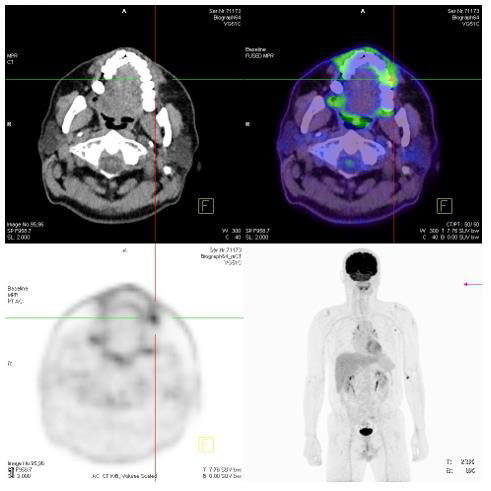Amniotic Fluid Embolism
Case Report
The case presented in this paper describes 37 years old woman, who was pregnant for the second time, in the 38th week of gravidity. She was obese and diabetic treated by antidiabetic therapy and with placenta in lower level. The birth was induced by prostaglandins. Thirty minutes after disruption of amnion, nausea, dyspnoea, consciousness alternated with unconsciousness, cyanosis development of upper part of the body, followed by tachypnoea, symptom of blue mask, tachycardia, blood pressure was not possible to be measured, without clear symptoms of haemorrhage, babies’ hearts activity was 140 per minutes. According to the examination strong dilatation and dysfunction of right heart chamber were found. According to the hypercontrability of the left heart chamber a suspicion of massive lung embolism was stated. Cardiac surgeon congress agreed with the diagnosis. From that moment foetus sounds to 60 per minutes altered. After stabilizing the patient in collaboration with obstetrics and anaesthetist, cardiologist, cardiac surgeon, and internal specialist Caesarean section with bilateral ligation artery hypogastricae and B - lynch stich for haemocoagulative disorder were performed. The foetus was born but after 48 hours she died because of consequences of strong intrauterine hypoxia. After the surgery the patient was stabilized at anaesthesiological department with final diagnoses of embolism caused by amniotic fluid and massive lung vasoconstriction. After half of a year the patient had only neurological symptoms in the meaning of disorders tactile motoric that was presented in reading and connected with anxious depressive disease. From the gynaecological point of view there are currently no obstacles. 37 years old woman secondly pregnant in the 38th weeks of pregnancy, obese, with diagnosis pregnancy diabetes treated antidiabetic therapy and with lower contact placentas. She was admited for induction of labour and the birth was induced by prostaglandins. When the regular contractions started, the disruption amniotic sack was done. After 30 minutes all dyspnoea, nausea, development of unconsciousness at the patient appeared. Cyanosis was developed on the upper part of her face, glycemy control 9mmol/l. Peripheral venous cannula, urethral catheterization, laboratory samples and oxygen delivery were performed. As the latest phase an anaesthesiologist was called. After 5 minutes of tachypnoea, shallow breathing – symptom of blue mask, the patient was saturated with 40% oxygen. ECG showed bigemminie and aberration QRS complex. The blood pressure was not possible to measure; venous carotids were without pathological filling. At that moment the patient was without symptoms of haemorrhage.
The control of foetus vitality, foetus sounds 140/min. The cardiologist came due to clinical state of patient. He performed a bed side ECHO resulting in strong dilatation and dysfunction of the right heart chamber, blood stagnation in the right heart chamber without evidence of intracardial thrombus and hypercontraction of left chamber. According to the results obtained from the ECHO examination, the suspicion of massive lung embolism was stated. We put our effort to stabilizing the patient together in collaboration with anaesthesiologist, internist, cardio surgeon and cardiologist.
During the artificial pulmonary ventilation, the oxygenation was 95%, ECG showed tachycardia 140/min, blood pressure was dropping down and even support for adrenalin controlling ECHO resulted in relative tonisation of right heart chamber. We controlled the foetus sounds and there was bradycardia to 60/min. After 45 minutes from the first symptom the patient was stabilized and prepared to surgery in general anaesthesia. A female foetus was delivered, 2840 grams and 47 centimeter’s, Apgar score 0-0-4. The newborn baby died after 48 hours. Because of haemorrhage and coagulation disorders during Caesarean section bilateral ligation and B-lynch stich was done. The complete blood loss was 4 litres and was compensated by blood derivate. After stabilizing the patient and stopping bleeding the patient was transferred to anaesthe-siological clinic.
The first day at the anaesthesiological clinic she was treated by pharmacologically, GCS 3, on artificial pulmonary ventilation, circulation was stable without catecholamines. ECG showed regular heart activity without rhythm disorder. Haemorrhage symptoms/ epistaxis, leaking injury, gynae-cological bleeding/. Antibiotic therapy - PNC, Gentamicin, Avrazor, LMWH /Fraxiparine/ and diuretics with ion substitution were applied. ECHO control of the heart was monitored. It was found out that the left heart chamber was without rhythm disorders and pericardial fluid, with adequate systolic function. The right chamber was wider with light pulmonary hypertension and strong tricuspidal regurgitation. Venous ultrasound of the legs confirmed that there was no thrombosis. Pulmonary X-ray - lungs full without focus. The second day of hospitalization at anaesthesiological clinic the pharmacological sedation was decreased, GCS 14, patient was conscious, collaborating, during the spontaneous ventilation breathing clear, circulation state without any support, diuresis without diuretics. The patient still received the antibiotic therapy, LMWH, infusion and nootropics. Control CT pneumoangiography proved no evidence of lung embolus. Gynaecological examination was without any additional therapy.
The third day of hospitalization at anaesthesiological clinic the patient was fully conscious, GCS 15, well oriented, without bleeding. Surgical wound was without symptoms. Antibiotic therapy, analgetic, prokinetic, ion substitution, LMWH went on. She orally accepted nutrition and physiotherapy started. She was transferred to cardiological emergency to compensate states. After the last examination the patient was without evidence of typical embolism. The diagnosis was determined as amniotic fluid embolism with massive pulmonary vasoconstriction. 11th day after the Caesarean section her circulation was stable, neurological finding in norm, haematologist ordered the usage of prophylaxis LMWH till the end of confinement. According to the ECHO the slight hypertrophy of the left chamber remained, but all other parameters were as expected. Nine months later after the embolism the opthalmological examination was performed. Both outer and inner finding did not show any symptoms. Neurological finding involved tactile motoric and executive functions. The result of psychological examination proved anxious depressive disease, affective and cognitive disorders of mid degree. The patient is prepared to be pregnant. On the base of all examinations, it was recommended to postpone the pregnancy for minimum one year.
For more Articles on : https://biomedres01.blogspot.com/

No comments:
Post a Comment
Note: Only a member of this blog may post a comment.